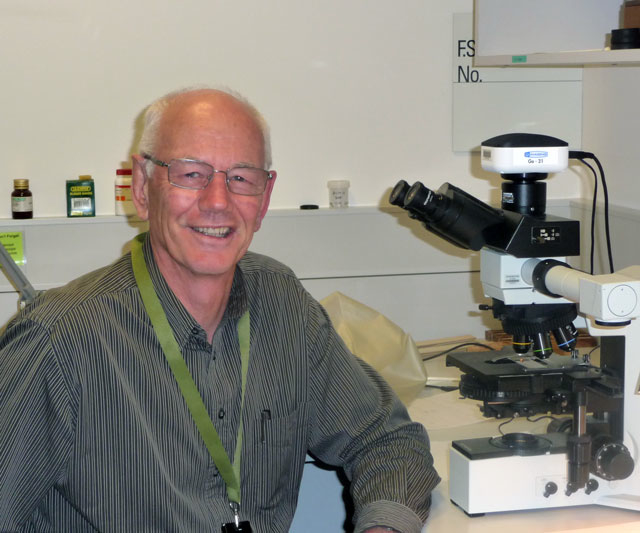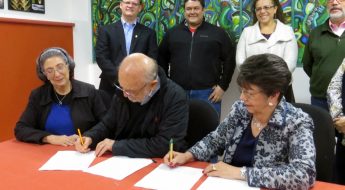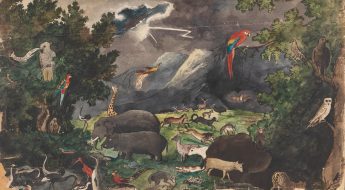BHL and Our Users: Dr. Gary Poore
As you probably know, BHL is a global initiative, with project nodes on every continent in the world except Antarctica. As a global effort, we think it’s important to highlight our user communities around the world. This week, we’ve collaborated with our friends at BHL-Australia to feature Dr. Gary Poore, an avid BHL user from “Down Under.”
Dr. Gary Poore is based at Museum Victoria in Melbourne, Australia. As the curator of the museum’s crustacean collection he has been researching the diversity of marine crustaceans for more than 30 years. He has been responsible for the naming of almost 400 new species over the course of his career and is renowned as a world expert on isopod and decapod crustaceans. Although he’s recently retired from his position at Museum Victoria, he is now a Curator Emeritus and still heavily involved in research and in the global crustacean taxonomic community.
He first learned about BHL when he toured the Internet Archive offices in San Francisco while a member of one of the Census of Marine Life steering committees.
As a taxonomist, Gary’s work requires that he regularly delve into the historical literature to ensure that any new species he might be describing has not been previously named, and that current nomenclature accords with the conventions of the International Code of Zoological Nomenclature. (It is surprising how much does not, he says). This involves searching potentially hundreds of documents dating back to 1758, the publication date of Carl Linnaeus’s Systema Natura, the starting point of our modern nomenclatural conventions.
To find and read the historical literature, Gary uses the BHL because it is always conveniently at his fingertips.
“This saves me so much time”, he says. “Without it, I would have to go through library catalogues, and if our library didn’t have an article, I’d waste days or weeks waiting for inter-library loans.”
Recently, Gary was asked by the Australian Faunal Directory to catalogue the species of Australian Pentastomida, or tongue worms, respiratory parasites of mammals, reptiles and birds. He was then encouraged to go on to publish a list of all the world’s 124 species. This required Gary to delve into the literature back to the earliest mention of each family, genus and species and having to call on some detective skills as he traced the names from contemporary literature back to their first publication.
During the course of his investigations, he discovered many anomalies and errors in the names of species and their attribution. For example, the name widely used name Pentastomida itself was widely attributed to Diesing, 1836, but the word did not appear in the literature until 1905. This and other nomenclatural and taxonomic projects in which Gary is involved would not have been feasible without access to the resources in the Biodiversity Heritage Library.
Another feature of the BHL that Gary likes is the ability to create personalised portable electronic libraries of extracts from numerous journals using the PDF tools linked to bibliographic software. These complement, and even go some way to replacing, the huge collection of paper article extracts that line the walls of the Marine Invertebrates lab at Museum Victoria.
“The BHL is a great resource for the researcher working in taxonomy”, says Gary. “It provides easy access to the historical literature, right back to Linnaeus and beyond”.






Rod Page is correct and I was wrong. A search for Pentastomida on BHL turns up its first usage in Huxley TH. 1869. An introduction to the classification of animals. London: J. Churchill & Sons.
Diesing (1836) discussed the genus Pentastoma Rudolphi, 1812 but not Pentastomida as commonly stated in the literature.
See my paper (with its wrong 1905 attribution of Pentastomida!)
Poore GCB. 2012. The nomenclature of the Recent Pentastomida (Crustacea), with a list of species and available names. Systematic Parasitology 82: 211-240 DOI 210.1007/s11230-11012-19363-x.
Thank you Emanuela for taking the time to provide a good history of Pentastomida's initial references.
Such a case illustrates the importance of having access to the legacy literature in order to track down species publication history. We do not yet have the 1835 volume of "Annalen Wiener Museums Naturgeschichte" but we will get it into the queue. Incidentally, "Beschreibungen einiger neuer Eingeweidewürmer" has been digitized by our partners in BHL-Europe and is available through Europeana, http://www.europeana.eu/portal/record/08707/83F88F07E004AF3A97C21C4869E6F46B4E0F6D8A.html?start=6. This title will be incorporated into the BHL in the future.
It seems that with the paper "Versuch einer monographie der Gattung Pentastoma" (Annales Wiener Museums Naturgeschichte, 1835 [1836], 1–32) Austrian Carl Moriz Diesing was the first to establish the proper nature of Pentastomida (although in this article he credits French veterinary Philibert Chabert as the first to discover it, in 1787. Chabert described it as Taenia lanceole'). You will often find this article dated 1836 because volume 1835 was the first of two and they were bound together. However, before C.M. Diesing, already Joseph A. Frohlich (Beschreibungen einiger neuer Eingeweidewürmer, 1789), Alexander von Humboldt (1811), and the Swedish Karl A. Rudolphi (1819), had studied and described this parasite, but naming it in different ways. Best regards.
Thanks for your feedback Rod. I agree with you that the term Pentastomida does appear to predate 1905 as mentioned in the article – 1832 is the earliest reference that comes up (http://www.biodiversitylibrary.org/page/35546070). I'm afraid that I'm not a taxonomist however, so I'll have to defer to someone qualified to give an explanation. I'll make some inquiries and provide an update to the post shortly.
Regards,
Joe Coleman
Nice post, Gary Poore's work on the Australian Faunal Directory mentioned in the post is here: http://www.environment.gov.au/biodiversity/abrs/online-resources/fauna/afd/taxa/Pentastomida.
However, I'm puzzled by the statement in the blog post that the word "Pentastomida" doesn't appear in the literature until 1905. This is patently false. A search of Google ngrams http://bit.ly/M4VJol has the word appearing in the 1860's. BHL's own search http://www.biodiversitylibrary.org/name/Pentastomida has pre-1905 references, e.g. (http://biostor.org/reference/92014, doi:10.1080/00222937308680777).
Diesing 1863 (http://biostor.org/reference/104258, may not be the first reference for this name, but neither is
Shipley's 1905 paper (http://biostor.org/reference/104255, http://www.biodiversitylibrary.org/page/31856778).
I agree that BHL is a great resource for tracking down the literature and checking whether citations actually provide the information authors claim, but "Pentastomida" clearly predates 1905.